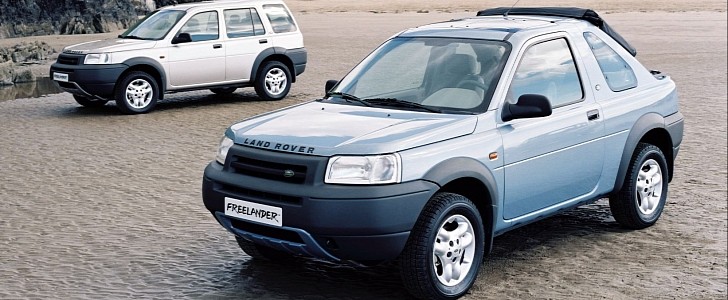Perhaps one of the most unsung heroes in Land Rover’s history is the Freelander, a small SUV that not only opened the door to a new set of fans, but also recalibrated the industry’s approach to small crossovers.
Until the Freelander debuted, conventional wisdom held that a true off-roader needed to have a fore/aft-oriented engine that primarily drove the rear wheels even in 4-wheel drive. Even better if it had body-on-frame construction, a solid rear axle and manually locking hubs.
At a time when other manufacturers were building what appeared to be rugged off-road small SUVs on car-based platforms (Toyota RAV4 and Honda CR-V), Land Rover took the same approach but decided to deliver the off-road capability that the company’s fans expected from the marque.
As a result, the Freelander employed a transversely mounted engine, unit-body construction and an independent front suspension rather than a solid axle. The Freelander was originally offered in three- and five-door versions including soft-top variant and came with a choice of a 4- or 6-cylinder engine.
While the Freelander lacked traditional four-wheel-drive kit like a low-range or locking hubs, this all-new Land Rover pioneered the use of electronic aids to greatly enhance its off-road performance.
The company took over 16 patents on technology such a pioneering Hill Descent Control. This system would pulse the vehicle’s brakes to control the vehicle’s downhill speed. It was a system that would be expanded across the Land Rover lineup.
Other innovations included the use of a viscous center coupling that replaced a traditional mechanical center differential and an Intermediate Reduction Drive (IRD) that varied the torque delivered to the front wheels.
Freelander also pioneered traction control incorporating an anti-lock braking system that was effective in both on- and off-road use. The first-generation Freelander enjoyed a nine-year production run and sales in excess of a half-million units. A 2006 remake was called Freelander 2 in Europe and marketed as LR2 in America. By then, Ford had taken over the brand from BMW and based the new model on the C1 platform. It was that model that was the first Land Rover to offer a front-drive variant. Production of the Freelander 2 and LR2 ended in 2015.
But this approach of using unit-body construction, transversely mounted engines and multi-link independent suspensions lives on. It opened the door for a whole range of crossovers for not only Land Rover in the Discovery Sport and Range Rover Evoque, but also SUVs for Jaguar in the form of the E-Pace, F-Pace and all-electric I-Pace models.
At a time when other manufacturers were building what appeared to be rugged off-road small SUVs on car-based platforms (Toyota RAV4 and Honda CR-V), Land Rover took the same approach but decided to deliver the off-road capability that the company’s fans expected from the marque.
As a result, the Freelander employed a transversely mounted engine, unit-body construction and an independent front suspension rather than a solid axle. The Freelander was originally offered in three- and five-door versions including soft-top variant and came with a choice of a 4- or 6-cylinder engine.
While the Freelander lacked traditional four-wheel-drive kit like a low-range or locking hubs, this all-new Land Rover pioneered the use of electronic aids to greatly enhance its off-road performance.
The company took over 16 patents on technology such a pioneering Hill Descent Control. This system would pulse the vehicle’s brakes to control the vehicle’s downhill speed. It was a system that would be expanded across the Land Rover lineup.
Other innovations included the use of a viscous center coupling that replaced a traditional mechanical center differential and an Intermediate Reduction Drive (IRD) that varied the torque delivered to the front wheels.
Freelander also pioneered traction control incorporating an anti-lock braking system that was effective in both on- and off-road use. The first-generation Freelander enjoyed a nine-year production run and sales in excess of a half-million units. A 2006 remake was called Freelander 2 in Europe and marketed as LR2 in America. By then, Ford had taken over the brand from BMW and based the new model on the C1 platform. It was that model that was the first Land Rover to offer a front-drive variant. Production of the Freelander 2 and LR2 ended in 2015.
But this approach of using unit-body construction, transversely mounted engines and multi-link independent suspensions lives on. It opened the door for a whole range of crossovers for not only Land Rover in the Discovery Sport and Range Rover Evoque, but also SUVs for Jaguar in the form of the E-Pace, F-Pace and all-electric I-Pace models.








